|

Autumn 2002 (10.3)
Pages
90-95
BTC Section - Between two seas
Progress
on the BTC Pipeline Project
by Mike Townshend,
CEO, BTC Pipeline Co.

For at least the past 10 years,
people have been talking about constructing a direct link between
the oil-rich Caspian Sea and the Mediterranean. Now this link
is on the verge of becoming a reality. It's the first strategic
and globally significant new oil project of the 21st century.
The Baku-Tbilisi-Ceyhan (pronounced JEY-han) project-BTC for
short-will break the mould in numerous ways. It will provide
the newly revived oil province of the Caspian with direct access
to world markets. It will mark the development of an energy corridor
between Asia and Europe. It will establish Sangachal and Ceyhan
as major terminal centres in the world energy industry. And it
will ensure that crude oil from the Caspian can be transported
outside the region safely, more economically and with less environmental
risk than if it was moved by additional tankers through the crowded
Bosphorus (Istanbul) Strait.
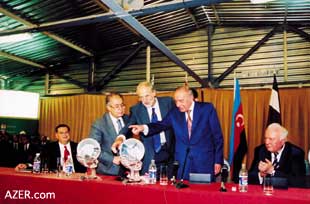  Left: Ceremony at the Sangachal Terminal
to launch the construction of the BTC pipeline. Attending were
the presidents of the three countries through which the pipeline
will cross: (l-r) U.S. Secretary of Energy Spencer Abraham, (standing)
Turkish President Ahmad Nejdet Sezer, BP President David Woodward,
Azerbaijani President Heydar Aliyev, and Georgian President Eduard
Shevardnadze. Left: Ceremony at the Sangachal Terminal
to launch the construction of the BTC pipeline. Attending were
the presidents of the three countries through which the pipeline
will cross: (l-r) U.S. Secretary of Energy Spencer Abraham, (standing)
Turkish President Ahmad Nejdet Sezer, BP President David Woodward,
Azerbaijani President Heydar Aliyev, and Georgian President Eduard
Shevardnadze.
For all three countries on the 1,760-kilometre route-Azerbaijan,
Georgia and Turkey-the BTC pipeline also promises lasting material
gains in the form of capital investment, jobs and skills training,
a strong new revenue stream for government, opportunities for
local businesses and community programmes designed to bring sustainable
benefits to people who live close to the pipeline-our neighbours.
Environmental considerations have played a central part in all
our calculations and planning that has been undertaken to date,
just as it will in the future. Earlier this summer, BTC Co. presented
separate Environmental and Social Impact Assessments (ESIA) for
public disclosure and discussion in each country. Following a
60-day comment period, the responses were gathered and then final
versions of the assessments were presented to each host government.
We now await approval to start construction.
It has taken us two years of hard work and total dedication to
get to this stage. The BTC project is a huge international undertaking
involving many different skills and nationalities and innumerable
technical and logistical challenges. Dozens of disciplines have
been thrown together-engineers and environmentalists, seismologists
and ornithologists, botanists, geologists and archaeologists-to
name a few. Dialogue has been the key to everything. Hundreds
of meetings with local and national groups were held during compilation
of the impact assessments and many more lie ahead as the construction
phase draws nearer.
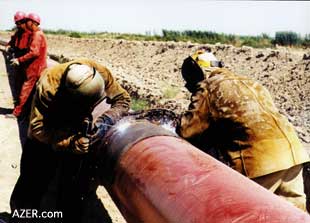  The main construction contracts have
now been awarded, but much more remains to be done. Our contractors
must mobilize their teams. Pipeline deliveries should start by
the end of the year, and digging the trench for the pipe is set
to begin in Spring 2003. By late-2004 the entire system should
be in place, ready for testing. First oil exports are expected
to flow through the line from Sangachal to Ceyhan early in 2005. The main construction contracts have
now been awarded, but much more remains to be done. Our contractors
must mobilize their teams. Pipeline deliveries should start by
the end of the year, and digging the trench for the pipe is set
to begin in Spring 2003. By late-2004 the entire system should
be in place, ready for testing. First oil exports are expected
to flow through the line from Sangachal to Ceyhan early in 2005.
Left: The BTC pipeline will require 150,000
pipe sections, each 12 meters long, for a total distance of 1,760km.
or 1,091 miles
The BTC project is a tremendous multinational challenge that
depends for its success on the creation of a true partnership
among all those involved. Our common goal is to turn a dream
into a reality in such a way that the pipeline is built and operated
safely and has minimal impact on the natural and human landscape.
As the construction phase approaches, we are confident that together
we can make the Baku-Tbilisi-Ceyhan pipeline a success for Azerbaijan,
Georgia and Turkey.
Why Build the Pipeline?
Pipelines are the safest, most secure method of transporting
crude oil-particularly when buried underground as the Baku-Tbilisi-Ceyhan
(BTC) pipeline will be along the entire route. Given the compelling
strategic and environmental need to develop a new route to market
crude oil from the Caspian Sea, BTC virtually selected itself.
The Caspian Sea is rich in energy reserves, yet its landlocked
status has long left it isolated from world markets. In recent
years, the region's global significance has increased markedly
as estimates of proven reserves of oil in the Caspian basin grew
to between 17-33 billion barrels-comparable to reserves in the
United States and perhaps double those in the North Sea.
One cluster of discoveries in the Caspian-known as the Azeri,
Chirag and Gunashli (ACG) field-alone has reserves estimated
at more than five billion barrels, and it was the commitment
to exploit this major resource that has necessitated the construction
of additional export capacity. Current output from the Chirag
field is exported via the Western Route Export Pipeline to Supsa
in Georgia and the Northern Route Export Pipeline to Novorossiysk
in Russia. The additional production likely to be generated by
ACG meant that new ways of transporting Caspian oil to the rest
of the world had to be investigated if the full potential of
the field was to be developed.
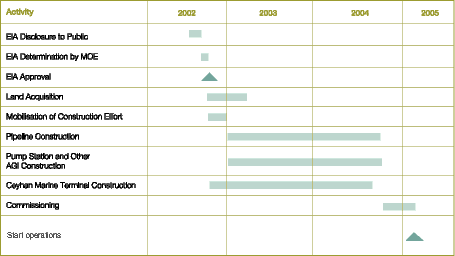
Above: Timeline for the various stages
of construction of the Baku-Tbilisi-Ceyhan pipeline, scheduled
to be completed in early 2005.
Environmental considerations dominated examination of the various
options prior to the decision to go ahead with the BTC project.
A pipeline offered many advantages over other methods of transportation,
but three stand out. It will not add to the shipping movements
in the already overcrowded Bosphorus Straits. It involves the
lowest environmental risk to the three host countries-Azerbaijan,
Georgia and Turkey. And it promises long-term economic and social
benefits to the three countries that it will cross.
When complete, the BTC project will provide a route to international
markets for one million barrels of oil a day and will turn the
region into a major energy player. Tax and other revenues generated
for governments along the route will make a large, and continuing,
contribution to the prosperity of Azerbaijan, Georgia and Turkey.
BTC Co.'s activities are managed by BP on behalf of an international
group of investors which also comprises SOCAR (Azerbaijan), Unocal
(USA), Statoil (Norway), TPAO (Turkey), Agip (Italy), TotalFinaElf
(France), Itochu (Japan), INPEX (Japan) and Delta Hess (Saudi
Arabia). The company, which was formed on 1st August in London,
has adopted BP's global policies on safety, environmental care,
employment practices and ethical business conduct.
Laying the Pipeline
  Left: The Baku-Tbilisi-Ceyhan pipeline will cross various
climactic zones, including desolate desert and mountain regions,
as it travels west from Baku to the Mediterranean port of Ceyhan,
Turkey. Left: The Baku-Tbilisi-Ceyhan pipeline will cross various
climactic zones, including desolate desert and mountain regions,
as it travels west from Baku to the Mediterranean port of Ceyhan,
Turkey.
One of the great engineering
endeavours of the new millennium will be the laying of the BTC
pipeline. The route crosses widely differing terrain reaching
a height of more than 2,800 metres as it traverses the mountainous
Caucasus region, passing through intensively farmed irrigated
agricultural land, fording 1,500 rivers and skirting 450 communities.
About two years of construction work will be involved, using
a carefully selected group of contractors with international
expertise in laying long-distance pipelines.
A number of specialised engineering techniques will be used along
the route, including dry open-cut crossing of rivers and streams
where the water flow will be maintained using temporary pipes,
and wet open-cut crossings where the river bed is excavated through
the running water.
Road and rail crossings will be achieved either by digging open
trenches half the width at a time to permit continued traffic
movement or by using auger or thrust bore techniques that do
not touch the ground surface. Each crossing has been evaluated
individually in order to keep disruption to communities and the
environment to a minimum. Construction normally will take six
to eight weeks as the project passes through an area, and measures
will be taken to minimise noise, dust and traffic during this
period.
Typically, soil will be stripped and levelled along the route
and a trench at least one metre deep will be dug. Sections of
pipe, coated protectively to prevent corrosion, will be stored
along the route before being delivered to the trench site. Then
the pipe sections will be welded together, lowered into the trench
and covered with excavated material. Average pipeline lay rates
are estimated at 700 metres each day. Topsoil and subsoil are
stored separately to ensure rapid and effective reinstatement
of the ground. Finally the terrain is reseeded and replanted
to restore it to its original form.
BTC Pipeline
Pipeline
Length: 1,760 km (1,091 miles)-Azerbaijan (445
km), Georgia (245 km), Turkey (1,070 km)
Cost: US$2.9 billion, including $1.4 billion for Turkey
section
Oil reserves in ACG field: at least 5.2 billion barrels
Capacity: One million barrels per day or 50 million tonnes
a year
Design life: 40 years
Maximum altitude reached: 2,800 metres
Communities on route: 450-Azerbaijan (80), Georgia (70),
Turkey (300)
Road & rail crossings: Azerbaijan (350), Georgia (250),
Turkey (300)
River crossings: Azerbaijan (30), Georgia (200), Turkey
(600)
Design & Construction
Basic engineering: November 2000-June 2001
Detailed engineering: June 2001-June 2002
Construction period: Two years
Construction workforce: Azerbaijan (2,300), Georgia (2,500),
Turkey (5,000)
Width of construction corridor: 32m average
Number of pipe sections: 150,000, each 12m long
Weight of steel pipe: 655,000 tons
Depth of pipeline: at least 1 metre underground
Operations
Number of pump stations: 8-Azerbaijan (2), Georgia (2), Turkey
(4)
Speed of oil through pipe: 2 metres per second
Working pressure of pipeline: 95 BAR for normal operation
Operational staff: 850-Azerbaijan (250), Georgia (250),
Turkey (350)
Sangachal terminal: Control room for BTC pipeline, 2 new
storage tanks, metering facilities, pumping station
Ceyhan terminal: 7 new storage tanks, 2.5km jetty with
2 loading berths, pipeline pressure reduction facilities, waste
water treatment plant, vapour incineration facilities, ship loading
control room
Power requirement: 130 MW-Azerbaijan (40 MW), Georgia
(40 MW), Turkey (50 MW)
Metering stations: 4-Azerbaijan (1), Georgia (1), Turkey
(2)
Consulting the
Community
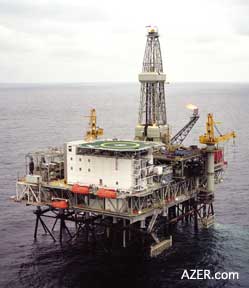  Public consultation and disclosure is
central to the BTC project. From the outset, a sustained effort
has been made to ensure that all stakeholders-including governments,
non-governmental organizations (NGOs), international scientists
and experts, local communities and local interest groups-have
been able to scrutinise the plans and exchange information, ideas
and potential solutions. Public consultation and disclosure is
central to the BTC project. From the outset, a sustained effort
has been made to ensure that all stakeholders-including governments,
non-governmental organizations (NGOs), international scientists
and experts, local communities and local interest groups-have
been able to scrutinise the plans and exchange information, ideas
and potential solutions.
Left: Chirag production platform in the Caspian
Sea.
During this process almost 20,000 landowners and users whose
land will be crossed during construction have negotiated with
BTC Co. In Turkey, workshops and meetings have been attended
by about 260 NGO representatives and 60 press organizations,
while face-to-face interviews have been held with nearly 2,000
households along the route. Similarly exhaustive consultations
have taken place in Azerbaijan and Georgia. A key objective has
been to minimise in advance the impact of the project on daily
life as far as possible and to offer fair compensation for damage
or loss of income. A clearly defined method is now in place to
resolve any disputes that may arise in the future. The consultations
so far have highlighted a number of issues, including the impact
of the project on the environment, land compensation, safety
security and health, reinstatement of land and the possible impact
of construction workers and construction camps on local residents.
These issues have been addressed in the project route and design
and its comprehensive management plans.
Communication and consultation will continue throughout construction
of the pipeline. Teams of locally recruited community relations
staff will be on hand to share information with community leaders
on a regular basis. Plans are also being drawn up for community
liaison during the operational phase of the pipeline.
Modifying the Route
One key principle guided the choice of route for the BTC project-that
it is far better to avoid creating a social or environmental
problem than it is to mitigate one that could have been averted.
Throughout route selection, a number of factors dictated how
decisions were made. Known sensitive areas or areas of high population
density were avoided. So were known cultural monuments, archaeological
sites and geohazards. The safety of both the construction and
operation of the pipeline was a central issue, as was the need
to minimize the risk of oil spills. In addition, the amount of
land needed was reduced to a minimum-the working width for the
BTC pipeline is 32 metres in Azerbaijan and Georgia, reducing
to 28 metres in Turkey. The aim always is to make no more disturbance
than is necessary for safe working.
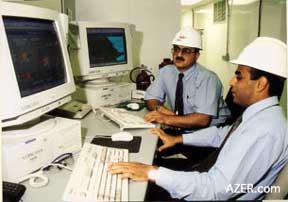  Left: Approximately 250 new positions will
be created for Azerbaijani workers related to the operation of
the BTC Pipeline. Left: Approximately 250 new positions will
be created for Azerbaijani workers related to the operation of
the BTC Pipeline.
Below: Chirag
production platform in the Caspian Sea.
An initial selection involved detailed walking along the route
by engineers, environmentalists, sociologists, archaeologists,
botanists and zoologists, who produced a "preferred corridor"
and subsequently a 100-metre-wide "specified corridor"
which was then presented to the host governments. Later a number
of alterations were made. For example, in Turkey a total of 179
archaeological sites have been revealed within a one-kilometre
corridor along the route, most of which have been avoided. In
Azerbaijan, where the BTC project mostly runs parallel to an
existing pipeline, any significant deviations have been the result
of environmental considerations.
In all, some 200 route changes have been made since the start
of the project. One result of this meticulous process is that
not a single person will have to move from their home. And an
important side benefit of all this painstaking work is the major
contribution the project is making to the scientific understanding
of the environment and cultural heritage along the BTC route.
Operating the Pipeline
The distance from Baku to Ceyhan by pipeline is 1,760 kilometres-445
km in Azerbaijan, 245 km in Georgia and 1,070 km in Turkey. Along
the way there will be eight pump stations, one pressure reduction
station, four metering stations and 98 block valves. Sangachal
terminal, on the shores of the Caspian Sea in Azerbaijan, marks
the starting point of the route, while a marine terminal at Ceyhan,
adjoining the Mediterranean Sea in Turkey, represents the end
of the long journey.
Sangachal, originally completed in 1997 and able to export both
oil and gas, is now being expanded to handle increased oil production
from the ACG field. This project will be completed in 2004 and
involves installing extra storage tanks and equipment to meter
and prepare crude oil for delivery into the pipeline.
  At Ceyhan, a new facility on a 135-hectare
site is set to be operational in 2005. This includes a tank farm
of seven oil storage tanks, a metering system and a housing compound.
Also under construction is a 2.5 kilometre jetty with two berths.
Here tankers of between 80,000 and 300,000 tonnes will be loaded
with crude oil for delivery to refineries around the world. At Ceyhan, a new facility on a 135-hectare
site is set to be operational in 2005. This includes a tank farm
of seven oil storage tanks, a metering system and a housing compound.
Also under construction is a 2.5 kilometre jetty with two berths.
Here tankers of between 80,000 and 300,000 tonnes will be loaded
with crude oil for delivery to refineries around the world.
Between Baku and Ceyhan, key installations include the eight
pumping stations-each designed to minimize intrusion into the
landscape and all permanently manned. These stations will provide
hydraulic power to boost oil flow through the pipeline as well
as give access for regular cleaning and inspection. Valves designed
to block the flow of oil will be positioned at approximately
20-kilometre intervals to enable sections of the pipeline to
be isolated in an emergency.
Several stations will include metering facilities to measure
the flow of oil. It is these measurements which will give the
statistical basis on which taxes and other payments are made
by the BTC Co. to host governments. Before the first crude oil
is introduced into the pipeline, the entire structure will be
pressure tested thoroughly, using water to prove its strength
and integrity.
Overall control of the pipeline will be carried out from Sangachal.
Everyone working on the project, including contractors, will
receive professional skills training to ensure safe and reliable
operation. Closed circuit television will operate at intermediate
pump stations and other facilities backed up by an advanced security
system. The route will be inspected regularly by BTC Co. staff,
which includes patrols on horseback in remote areas.
Economic Benefits
By tapping into the riches of the Caspian Sea, the $2.9 billion
BTC project will create lasting economic and social benefits
for the peoples of Azerbaijan, Georgia and Turkey. During the
two-year construction phase, approximately 10,000 workers-skilled,
semi-skilled and unskilled and many from communities along the
route-will be employed, including 5,000 in Turkey, 2,500 in Georgia
and 2,300 in Azerbaijan. Subsequently, about 850 permanent pipeline
jobs will be created in the three countries for staff who will
operate the pipeline and Sangachal and Ceyhan terminals.
Local businesses can expect to benefit by supplying a wide range
of goods and services to the project during and after the construction
phase, while landowners and users affected by the pipeline will
receive fair compensation for any loss or damage they may sustain.
Once the project is operating, it will generate new revenues
for each host country through tariffs related to the flow of
oil. Beyond this, a range of community and environmental investment
programmes will be set up by BTC Co. to help to deliver lasting
benefits. The aim of these projects is to provide some immediate
improvements to the quality of life in communities along the
BTC route and also schemes which will provide sustainable economic
opportunities for local populations.
Assessing the Risk
As part of the approval process for the BTC project, independent
Environmental and Social Impact Assess-ments (ESIA) have been
undertaken in the past two years in all three host countries.
The goal has been to ensure that issues arising from the pipeline
are identified and, where possible, eliminated or offset before
construction begins.
International consulting companies including Environmental Resources
Management (ERM), URS Environment and RSK Environment, together
with specialist Turkish, Georgian and Azerbaijan partners, undertook
this huge task. In each country, this began with an information-gathering
exercise designed to gain broad understanding of the project
and the social and environmental conditions along the likely
route. During this process, meetings were held with a wide range
of informed national and international opinion-formers together
with local communities on the pipeline route. Over time, these
meetings became more and more interactive, involving exchanges
of information and ideas. Subsequently, several in-depth environmental
and social surveys were undertaken. Throughout this process,
four objectives were kept firmly in focus-the need to minimize
the BTC "footprint" and do no lasting damage to the
environment; the obligation to create no new access routes; the
commitment by BTC Co. to restore all natural habitat; and the
requirement that no people be resettled and no permanent disruption
be done to the livelihoods of local populations.
In the summer of 2002 the three ESIAs were published, identifying
many measures that will be implemented to lessen the environmental
and social impact of the pipeline. Sixty days were then allowed
for public reaction before the final reports were submitted to
the three governments in October. Consultation will continue
throughout the life of the BTC pipeline. But the bottom line
as the project begins is best summed up by a statement in the
Georgian ESIA: "There are a few residual concerns relating
to the construction of the pipeline which need to be carefully
managed(But) it is generally anticipated that both the construction
and operation of the BTC pipeline will bring a series of short
and long term benefits to the communities."
Protecting Nature
One of the greatest challenges facing the BTC project is protecting
the fragile natural environment in the region. Along its lengthy
route, the pipeline passes through many areas of great biodiversity
that are rich in both plant and animal life-everything from forests,
wetlands and alpine meadows to endangered species such as wild
orchids, vipers, brown bears and white-headed ducks.
In Azerbaijan, protection of the deserts in the proposed Gobustan
National Park is a priority. In Georgia, Caucasian black grouse
on Mt. Taukvetili and wetlands at Narianis Veli and Ktsia are
high on the list. In Turkey, more than 500 endemic species have
been identified within a 500-metre corridor of the pipeline route,
which will also cross two nationally-protected sites and skirt
about 50 ecologically sensitive areas.
Given what is at stake, huge efforts have been made to reduce
the environmental impact of the project. A number of sensitive
areas have been avoided by detailed changes to the pipeline route.
One of the most important involves the Alacorak and Ulas Lakes
in Turkey-a complex of five lakes of international renown. In
a number of locations the timing and duration of construction
has been altered to fit in with fish and bird breeding, bird
migration patterns and the hibernation periods of the Eurasian
Brown Bear.
Some disturbance of habitats and species is unavoidable. And
it has not always proved possible to avoid routes through protected
areas; in Turkey, for example, the pipeline will go through the
Posof wildlife area and the Sarikamis Forest. Once construction
is complete, however, a reinstatement process will begin which
will include species transplantation, where necessary, and surveys
to monitor the long-term progress of reinstated areas.
More information on the BTC
pipeline project, including full Environmental and Social Impact
Assessments for the three countries crossed by the pipeline route,
can be found on this web site: www.caspiandevelopmentandexport.com.
Contact BTC for a brochure describing
the project:
In the UK: c/o BP, 1st Floor, Building C, Chertsey Road, Sunbury
on Thames, Middlesex TW16. 7LN. Tel: (44) 1932-738-049
In the USA: c/o BP Corporation,
1776 "I" Street NW, Suite 1000, Washington DC 20006-3700.
Tel: (202) 785-4888
In Azerbaijan: c/o BP Exploration,
2 Neftchilar Prospect (Bayil), Villa Petrolea, Baku 370003. Tel:
(994-12) 97-92-26.
____
Back to Index
AI 10.3 (Autumn 2002)
AI Home
| Search | Magazine
Choice
| Topics
| AI Store | Contact us
Other Web sites
created by Azerbaijan International
AZgallery.org | AZERI.org | HAJIBEYOV.com
|








